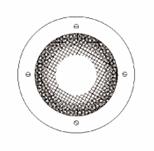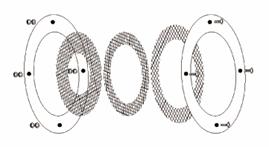Apodizing Masks?
Jack Kramer
Amateur astronomers are always experimenting with new ways to coax more details out of images in their telescopes. One trick that probably few of us have tried is an "apodizing mask", sometimes referred to as a "Lyot mask". This is a sort of graduated filter at the edge of the objective's field. Basically, it's made out of window screen (some comments indicate metal screening is preferred) and placed over the opening at the front of the telescope tube. A circular hole is cut in the center of the screen, then another screen with a slightly larger hole is placed over the first and rotated about 30o, then a third screen with a still larger hole is placed over the others and again rotated 30o. Central holes are cut in the following diameters based on a percentage of the size of the primary mirror: 1st screen: 55%, 2nd screen: 78%, and 3rd screen: 90%. The size of the holes in a 10-inch telescope would then be: 5.5"; 7.8"; and 9".

 Does it have any advantages? Internet correspondent Tim Hickman reported: "I constructed an apodizing screen for my 10" Dob using the plans by Fred W. Price from his book The Planet Observer's Handbook. I was skeptical that it would make an improvement in seeing details on planets. But it does!"
Does it have any advantages? Internet correspondent Tim Hickman reported: "I constructed an apodizing screen for my 10" Dob using the plans by Fred W. Price from his book The Planet Observer's Handbook. I was skeptical that it would make an improvement in seeing details on planets. But it does!"
I was puzzled as to how this thing works, so it took some further searching and correspondence to understand what's happening. Canadian astrophysicist Grant Gussie explains the apodizing mask: "It has to do with the wave nature of light. What you see through a telescope when you look at a star isn't really an image of the star as you would intuitively think of an image, it is a wave interference pattern...usually called a 'point spread function'. The point spread function of a clear circular aperture (where 'clear' means that all points across the aperture contribute equally, like in an unobstructed telescope), is the familiar Airy pattern: a bright central dot surrounded by concentric rings, with each ring much fainter than the one inside of it. Now imagine we add an apodizing screen. This 'shapes' the aperture, so that the center contributes more light per unit area than the edges do. This naturally changes the wave interference pattern by changing the distribution of waves that do the interfering. So what is the point spread function of this? It turns out it is quite similar to the clear aperture's PSF, but the central dot is slightly broader, and the concentric rings surrounding it are much fainter.
The net result is that contrast is improved (less light scattered in the diffraction rings), at the expense of less resolution (the central dot is wider). If however the telescope aperture is large enough that resolution is seeing limited even with the mask in place, then the improvement in contrast occurs "for free".
By the way, we can calculate the point spread function of any aperture mathematically with something called the Fourier transform. This is a very useful bit of mathematics and shows up all the time in all sorts of computer calculations (practically all digital signal analysis involves Fourier transformations). Look up the acronym FFT (fast Fourier transform) in Google and see all the pages devoted to it. If you signed up for SETI@home your computer spends lots of time calculating FFTs.
Ideally what you want is a progressive filter that has zero density in the center, and whose density increases to 100% at the edge, with the density increasing according to the square of the distance from the center. This gives the "best" point spread function in terms giving the optimal balance between resolution and diffraction ring suppression. The sizes of the layers' central holes were chosen to approximate that as closely as possible using three layers.
And why have just three layers with one big hole in the center, why not more layers? Theoretically more layers would be better, and an infinite number of infinitely thin layers would be best, but three layers seems to offer almost all of the benefits and still offer very simple construction. But as stated above, what you really want is an outwardly progressive neutral density filter. Making one is impractical however.
What is the importance of a central 'hole'? A central clear area is pretty important. Otherwise the PSF gets way too broad, and resolution goes to pieces. But more importantly, in this case you are using a screen, rather than a neutral density filter, for the apodizing. You have to have an open center in this case, because if you completely cover a telescope aperture with a screen you would see nothing but rainbows. Try it sometime.
By the way, radio telescopes are almost always 'apodized', in that their receivers' sensitivity drops off as one approaches the outside edge of the reflecting dish. Again, this is done to maximize the signal to noise ratio ('contrast') at the expense of spatial resolution, and it works quite well in this situation. Professional astronomers however almost never apodize large optical telescopes, even for imaging."
A Google search will retrieve several web sites with info on apodizing screens; one such site is: http://www.rmss.org/gallery/article4.html
Having never used an apodizing mask myself, I can't vouch for its effectiveness, but I think that if your telescope already provides a sufficiently high-contrast view, then it would be of little value. Reflecting telescopes (due to the central obstruction) benefit most from such a device. However, reports indicate that it is also of value when seeing conditions are poor or when observing a planet near the horizon. In this case, it might steady the view in any telescope.
Published in the August 2006 issue of the NightTimes




